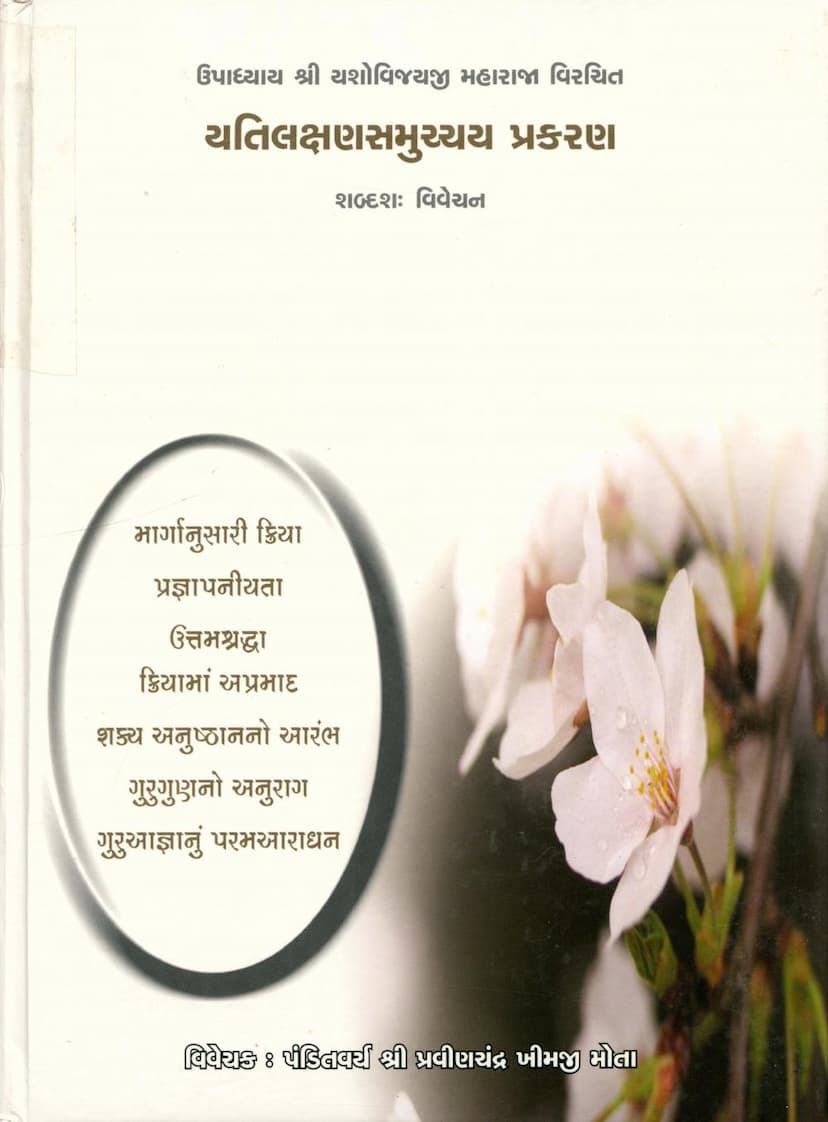Yatilakshan Samucchay Prakaran
Added to library: September 2, 2025

Summary
This document summarizes the Jain text "Yatilakshan Samucchay Prakaran," authored by Yashovijay Upadhyay and featuring commentary by Pravin K Mota. The book, published by Gitarth Ganga, delves into the characteristics and conduct of a Jain monk (Yati).
Key Concepts and Themes:
-
Seven Characteristics of a Yati: The text outlines seven essential qualities that define a true monk (Yati):
- Marganusari Kriya (Following the Path): Adhering to actions prescribed by scriptures and practiced by the virtuous and learned. This path is divided into the path of scripture and the path followed by the virtuous majority.
- Pragnapaniyata (Teachability/Guidance): A monk should be receptive to correction and guidance from their preceptor, being willing to learn and mend their ways.
- Uttam Shraddha (Supreme Faith): Unwavering faith in the teachings of the Jinas, recognizing them as the sole cause of ultimate well-being. This includes four aspects: Vidhi Seva (observing rituals), Atripti (insatiable desire for spiritual progress), Sudeshana (giving right discourses), and Kshit Parishuddhi (purification of faults).
- Kriya ma Apraamad (Non-negligence in Actions): Diligence and carefulness in all conduct, avoiding any lapse or carelessness.
- Shakya Anushthan no Aarambh (Initiating Feasible Practices): Undertaking spiritual practices that are within one's capacity, rather than attempting the impossible, which can lead to downfall.
- Guru Gun no Anurag (Affection for the Guru's Qualities): Deep respect and love for the virtuous qualities of the preceptor.
- Guru Ajna nu Param Aradhan (Supreme Adherence to Guru's Command): Absolute obedience and devotion to the Guru's teachings and directives, considering them paramount.
-
Interpretation of Scripture and Practice: The text addresses the nuances between scriptural injunctions and the practices followed by enlightened beings (Gitasrthas) in different times and circumstances. It explains how practices might evolve due to changing times (like the current era of Durvikshakal - a time of spiritual decline) while remaining true to the essence of Jain principles and the ultimate goal of liberation.
-
The Role of the Guru: The importance of a preceptor (Guru) is highlighted throughout. The Guru's guidance is essential for understanding scriptures, correcting errors, and attaining spiritual progress. The text emphasizes respecting and adhering to the Guru's teachings, even if they appear unconventional, as they are guided by profound knowledge and the ultimate welfare of the disciple.
-
Distinction between True Monks and Others: The text implicitly and explicitly distinguishes true monks (Yatis) who embody these characteristics from those who merely wear the outward garb without inner transformation. It stresses that external practices alone do not constitute monkhood; the inner disposition and adherence to these seven characteristics are crucial.
-
Scholarly Commentary: The book includes a detailed commentary (Vivechan) by Pandit Shri Pravinchandra Khimji Mota, which elucidates the original verses (Gathas) composed by Upadhyay Shri Yashovijayji Maharaj. The commentary aims to make the profound philosophical and practical aspects of the text accessible to a wider audience.
-
Relevance in the Current Era: The text acknowledges the challenges of the current era (Dukhkham Kaal) and explains how monks with these characteristics are still attainable, even in difficult times, through devotion and adherence to the Guru's path.
In essence, the "Yatilakshan Samucchay Prakaran" serves as a guide for aspiring Jain monks and scholars, providing a comprehensive framework for understanding the spiritual discipline, ethical conduct, and devotional practices required for a life dedicated to Jainism's ultimate goal of spiritual purity and liberation. The commentary by Shri Pravinchandra Khimji Mota further enriches the understanding of the original teachings, making them relevant and applicable for contemporary readers.